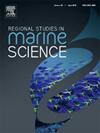Horizontal distribution and abundance of red seabream (Pagrus major) in the East China Sea and Sea of Japan based on standardized catch per unit effort
IF 2.4
4区 环境科学与生态学
Q3 ECOLOGY
引用次数: 0
Abstract
Red seabream (Pagrus major) is an important fisheries species in Japan, where it has been managed since 2025. Accurate stock assessment is necessary for rational fisheries management, and catch per unit effort (CPUE) is one of the key indexes used for this purpose. In the present study, the CPUE of red seabream in the East China Sea and Sea of Japan was standardized by incorporating seawater temperature and salinity based on fishing data obtained from bottom trawlers operating in key fishing grounds in these regions. We used data from operation reports available from 1982 to 2022, including fishing positions and efforts during each cruise and incorporated temperature and salinity data into the model from 1993. We applied a delta log-normal model for CPUE standardization and revealed an increase in this index since the early 1990s. We examined the horizontal distribution patterns of red seabream in each fishery grid that is 30 × 30 min latitude and longitude, and observed that the high-CPUE area extended northeastward from Taiwan to Japan along the shelf edge, which corresponds to the main fishing grounds covered by Japanese fleets after 2000. The probability of presence of red seabream increased drastically when water temperature at a depth of 50 m exceeded 15 °C. The reasons for the observed stock fluctuations may be a reduction in fishing pressure and warming seawater temperature.
基于单位努力标准化渔获量的东海和日本海红鲷水平分布和丰度
红鲷(Pagrus major)是日本重要的渔业物种,自2025年以来一直对其进行管理。准确的种群评估是合理渔业管理的必要条件,而单位努力量(CPUE)是实现这一目标的关键指标之一。本研究基于东海和日本海重点渔场底拖网渔船的捕捞数据,结合海水温度和盐度,对东海和日本海红鲷的CPUE进行了标准化。我们使用了1982年至2022年的作业报告数据,包括每次巡航期间的捕捞位置和工作量,并将1993年的温度和盐度数据纳入模型。我们对CPUE标准化应用了delta对数正态模型,发现自20世纪90年代初以来该指数有所增加。在30 × 30 min经纬度范围内,研究了各渔场网格内红鲷的水平分布格局,发现高cpue区域沿大陆架边缘从台湾向东北方向延伸至日本,与2000年后日本渔船的主要渔场相对应。当50 m深度的水温超过15 °C时,红鲷出现的可能性急剧增加。鱼类数量波动的原因可能是捕捞压力减少和海水温度升高。
本文章由计算机程序翻译,如有差异,请以英文原文为准。
求助全文
约1分钟内获得全文
求助全文
来源期刊

Regional Studies in Marine Science
Agricultural and Biological Sciences-Ecology, Evolution, Behavior and Systematics
CiteScore
3.90
自引率
4.80%
发文量
336
审稿时长
69 days
期刊介绍:
REGIONAL STUDIES IN MARINE SCIENCE will publish scientifically sound papers on regional aspects of maritime and marine resources in estuaries, coastal zones, continental shelf, the seas and oceans.
 求助内容:
求助内容: 应助结果提醒方式:
应助结果提醒方式:


